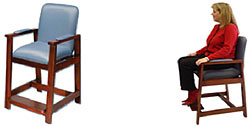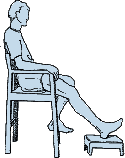 |
 |
|
Home Rehabilitation Choosing the Right Chair for Home Use Patients who undergo hip replacement surgery should not sit in low seated chairs because the effort needed to rise from them (called forward trunk lean) could result in the freshly implanted hip slipping from the socket. A higher seat allows the patient to sit and stand without registering the high stresses on the hip joint that are applied during this otherwise routine maneuver. It is simple enough to make a higher seated chair. In fact a bar stool meets the criteria. But there are some problems with these types of seats. If you’ve ever had the experience of hoisting yourself onto a bar stool you’ll appreciate the first one. It’s not that easy. If you’ve just had your hip replaced, it may not even be possible. Once seated, the second problem becomes obvious; where do you put your feet? Two possibilities come quickly to mind, dangle them over the side or find a foot stool. Dangling one’s feet is a pleasant pastime if you’re sunning yourself off the side of the family yacht, but for the fresh post-op hip patient, it’s not such a good idea. Foot stools will work but they must be movable so that the correct positioning of the hip angle can be attained. It would be better if the floor could be used. Finally, you’ve got to be able to get out of the chair. Exiting a high seat allows the post-op hip patient to avoid the stresses of forward trunk lean on the surgical site. A higher seat is a good thing. But how far should you have to jump? Falling on the floor won’t help to stabilize the freshly implanted hip. The pictures below are of ‘bar stool’ types of chairs widely available for home use following hip replacement surgery. They are affordable for most patients to buy, but are they the right chair for this application?
The images below are taken from the European Orthopedic Society. The first three show improper usage of the common ‘bar stool’ type of hip chair shown above. In all three the critical hip-torso angle (hip flexion) is equal to or greater than 90 degrees. This increases the probability of dislocation, particularly in patients who have undergone revision surgery. The third image in particular shows the difficulty of entering and exiting the chair and avoiding the forward trunk lean that leads to dislocation. These chairs are like SUVs i.e. high centers of gravity that introduce an unacceptable degree of instability into the equation.
The image below shows the correct use of the ‘bar stool’ model hip chair. There are several points to be made here. The surgically repaired leg must be extended in order to achieve a hip-torso angle less than 90 degrees. To attain this position using a high seated chair, a foot stool is needed. Wrapping the feet under the chair will cause the patient to lean forward as in the middle image above in order to feel comfortable. A lack of backward pitch in the back results in a loss of lower back support. Thus, the patient is required to make adjustments that are counterproductive.
The ‘bar stool’ model hip chair is commonly sold to individuals for use at home following hip replacement surgery. A disclaimer on one web site that offers this type of chair states, “As this product may only be needed temporarily, it is not returnable.” This is not a clinically valid statement. There is a consensus among experts in the field of ergonomic seating that the chairs most people sit in today are too low and too soft, and increasingly not wide enough. Measurements made at the Gait Analysis Lab at Mass General Hospital show that knee and joint stress are doubled and the hip must withstand up to 3000 PSI during sitting and standing from a 'normal' height chair. Thus, people who have undergone hip replacement or back surgery should sit in a higher, firmer chair for the rest of their lives. The guidelines for a proper ergonomic chair are listed below (Arthritis Foundation). • Easy to get in and out of For hip replacement patients, we would add that the hip flexion must be less than 90 degrees. Does the ‘bar stool’ model chair meet these requirements, and if not is there a chair commercially available for the home that does? The answers are no and yes.
The Ascender 9000 @Home chair is designed specifically for those patients who have undergone hip replacement surgery, or who have medical problems (other orthopedic problems, arthritis, neurological disorders, obesity etc.) that require special seating. It is a natural offshoot of our high-end hospital grade chairs that are the choice of many of the most prestigious orthopedic programs in the country. A comparison of this chair to the ‘bar stool’ model appears below.
* Ranges from 70 to 80 degrees depending on the slant seat position. The salient design features of the Ascender 9000 @Home chair are the slightly pitched back, the extended easy grip armrests, and the adjustable forward sloping seat pan (Patent Pending). The combination of adjustable seat pan (0, 5, and 10 degrees) and pitched back help to maintain the hip angle at approximately 70 to 80 degrees. The pitched back, open at the bottom, provides lower back support and a degree of comfort unmatched in any medical specialty chair. The combination of higher, extended easy grip armrests and the adjustable seat pan facilitates entry and exit, precluding the need for a very high seat. Because the seat is 20 inches from the floor and the frame is ‘A’ shaped, there is greater stability (and safety) for the patient precluding the need for imbedded and ineffective footrests. The Ascender 9000 @Home Chair is superior to any ‘bar stool’ model hip chair. In addition, it is an attractive chair so that patient will not want to return it or shove it in a corner after a couple of weeks. The 9000 meets a wider range of seating deficits; it is not simply a hip chair, and it is not exclusively for the home. It should prove an attractive option for sub acute care facilities treating the fresh post op orthopedic patient, the elderly or bar iatric patient. Equally important, the Ascender 9000 @Home is very affordable.
|



